Technical Information
A Complete History of the Vertical Wind Tunnel
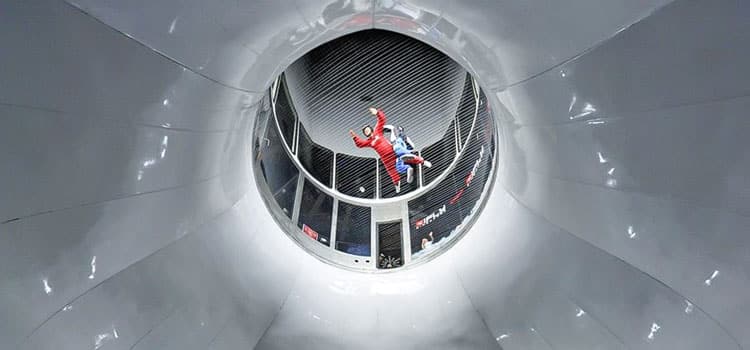
A vertical wind tunnel is simply a machine that moves air vertically. These tunnels are often used for aerodynamic research, however the recent past has seen an explosion of tunnels being constructed for human flight. Wind tunnels that are built specifically for humans to fly in, are often referred to as skydiving simulators, indoor skydiving tunnels or simply wind tunnels. This article will cover the complete history of the people and machines involved with the development and growth of this modern activity.
Early Innovation & Applications
Since the end of the 19th century, horizontal wind tunnels have been used for aerodynamic research. Horizontal wind tunnels were inadequate in certain testing situations. Because of this, the first vertical wind tunnels were created to test aircraft spins, helicopter blades, and parachutes.

The first ever vertical wind tunnel on record is the 20-Foot Vertical Spin Tunnel built at the NASA Langley Research Center in Hampton, Virginia which was completed in 1940. This wind tunnel had an approximately 58 mph top speed which was too slow for human flight. (1a) Shortly after the TsAGI vertical tube T-105 was built in Zhukovskiy, Russia in 1941. (1) Again after that, a vertical wind tunnel was built on the Wright-Patterson Air Force Base near Dayton, Ohio. The tunnel was Building 27 in Area B. The tunnel began initial construction in 1945. (2)
The tunnel at Wright-Patterson became famous in the world of indoor skydiving due to the fact that in 1964 the late Jack Tiffany became the first recorded human to ever fly in a wind tunnel at the Wright-Patterson machine. (2a) At that time, Jack was working with the Apollo space program testing parachute clusters. (17) In a 2008 interview, he stated “We were running damn near around the clock,” he told Military Times. “It was 2 a.m., and everyone was a little slap-happy. I said: “Fire this puppy up. I think I can fly. They fired it up, and I flew.” (3)
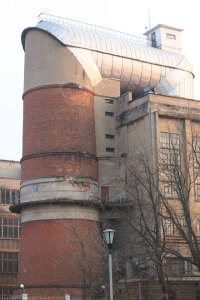
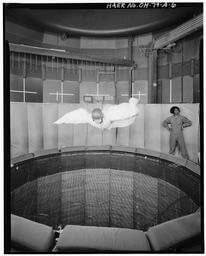

A video showing spin testing at the Wright-Patterson Vertical Wind Tunnel
Modern Wind Tunnel Development
The first wind tunnel designed and built specifically for human flight began construction in Canada near Montreal in 1978. The machine was designed by inventor Jean St-Germain (4) and constructed by the now Aerodium Technologies. Jean St Germain originally built this machine so that his kids could experience freefall in a safe environment. (17) The tunnel featured a propeller below design. The air-stream was created by a DC-3 engine and prop which sat below the flyer under a steel reinforced net and cage. The flight chamber was built with the air column in the center and a padded surrounding area which kept flyers safe if they were to fall out of the column of air.
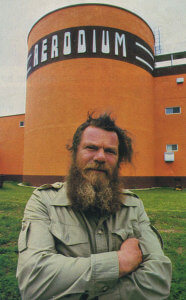
For $4 per minute, and $3 for a suit rental, a visitor could fly in the Aerodium. St Germain later sold the design to Les Thompson of Pigeon Forge, Tennessee, and former Boston Celtics owner Marvin Kratter. Soon after St Germain sold the franchising rights to Kratter for $1.5 million. (5)
Thompson built Flyaway in Pigeon Forge and Kratter built Vegas Indoor Skydiving. During the construction phase, the two facilities were in competition to open first. The Las Vegas location ended up winning the race due to a fire during construction of the Pigeon Forge location. (17)
After St Germain’s introduction, there were many other propeller below designs created of mobile, semi-permanent and permanent installations. The original Aerodium tunnel built by St Germain was later rebuilt as an outdoor tunnel and eventually dismantled and the remaining parts sold in 1998. (17)
Outdoor wind tunnels of a similar design often made appearances at skydiving dropzones. There were also wind tunnel scenes in both the 1994 movie Dropzone and the 2000 movie Cutaway.
Wall-to-Wall Revolution
In early 1997 a patent was filed by SkyVenture (7) showing the first modern wall-to-wall wind tunnel design. The model is what has come to be referred to as an open-flow design.
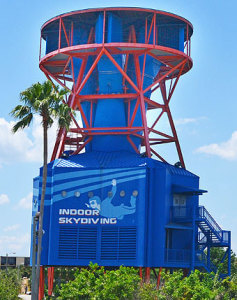
Instead of a single prop spinning below, the flight chamber pushing air upwards, multiple props with electric engines were placed above the chamber which pulled air up vertically through an enclosed flight chamber. A bell below the flight chamber causes the airspeed to increase in the flight chamber area. This design created a superior airflow since the turbulence created by the prop did not influence the airflow in the flight chamber. One downside to these models was the significant amount of noise they produced which could be heard from the outside.
This model was also the first to implement a permanently enclosed flight chamber. This means that the air flow was present from wall-to-wall. With this type of design, it is not possible fly out of the column of air. This brought an interesting new set of rules and a different approach to safety.
This design would be constructed and opened in 1999 as SkyVenture Orlando (now iFly Orlando) would be the first wind tunnel of its kind to open. Similar models manufactured by Sky Venture would then follow, opening in Malaysia, California, Spain, and Arizona. The disadvantage to these machines is the exposure to the outside elements. Because they pulled air directly from the outside environment, they lacked climate control.
Flight Chamber Sizes
Up until wall-to-wall designs, the size of a flight chamber namely the diameter fell to the size of the prop and was not restricted by walls. With wall-to-wall designs like SkyVenture Orlando, there was now an increased importance on the diameter of the flight chamber since it would restrict the possible flight area. SkyVenture Orlando is a 12-foot octagonal design. Aerokart was the first round 14-foot diameter wind tunnel opened in 2002. This was followed by SkyVenture Arizona which had a round 14-foot design as well.
This 14 foot minimum diameter became a very important factor as most modern indoor skydiving sport disciplines require a tunnel of at least this size. It is also the minimum ideal size for skydiver training, especially when speaking of 4 way RW training – the most popular skydiving discipline. In 2005 Bodyflight Bedford in the United Kingdom became the first wall-to-wall wind tunnel with a 16′ foot diameter. There are 17 foot diameter tunnels in the works with plans to be launched in 2015.
Skydiving’s Acceptance of Wind Tunnels
After the construction of SkyVenture Orlando it took a few years for skydivers to really accept and include wind tunnels into their training regimen. Belly teams like Arizona Airspeed and Deland Majik soon began running tunnel camps and coaching in Orlando. Because of these teams and camps, the tunnel began to fill up, and eventually ran around the clock. (17)
What started at SkyVenture Orlando, soon saw skydivers beginning to flock to vertical wind tunnels as they were quickly able to learn the skills they required to become better skydivers.
Freeflying – a type of skydiving where a skydiver falls in multiple orientations, including feet and head first – caused skydivers to fall at faster speeds. This meant that training this type of flying required faster wind tunnel speeds.
The Importance of Wind Speed
With the increased reliance on the type of machine and the accessibility for skydivers, SkyVenture Arizona became the holy grail for skydivers and the example for the modern wind tunnel industry to follow.
Built on the Skydive Arizona dropzone (skydiving facility) in Eloy, Arizona in 2005, SkyVenture Arizona offered the right size (14 foot, round) and enough wind speed (160 mph top speed) for skydivers to train all disciplines of flying, including freeflying.
Recirculating Innovations
In 2004 a patent was filed by SkyVenture showing the designs for a new type of wind tunnel. (8) This tunnel used the same prop and electric engine style as an open flow model, but instead of simply pulling outside air through a flight chamber, the air was contained in a closed circuit recirculating design. This design would go on to be built first in the United Kingdom and called Airkix Milton Keynes.
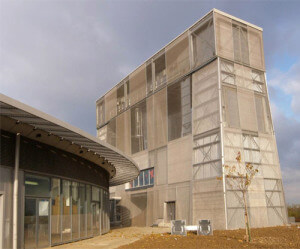
These recirculating tunnels offered a high quality wind flow without the exposure to the elements that previous tunnel models had. The downside to models like these, was that the heat of the motors and the recirculating wind caused the air temperatures in the flight chamber to rise to uncomfortable levels. In order to solve this problem, louver doors were added to the sides of the return air columns which allowed for outside air to be introduced which would cool the air temperature.
Recent years have also shown the addition of air conditioning units added to wind tunnels to cool the air as an alternative to louver doors. The air conditioners allow for a precise climate control without the downside of the external noise or having to sacrifice the wind quality that louvers saw. The lower noise levels have allowed wind tunnels to be constructed in places with noise restrictions.
With the introduction of the modern recirculating design, it now became possible to build wind tunnels in locations of all climates.
Although never manufactured, a patent filed by SkyVenture in 1998 showed the possibility of additional return air vents which could be added to their Orlando model, essentially turning the open flow design into a recirculating design. (9)
Manufacturer Diversity
With the introduction of the recirculating wind tunnel, SkyVenture took an early lead in the wind tunnel market and still to this day has the largest share.
Mobile and semi permanent propeller below installations were introduced by companies like Aerodium Technologies. It wasn’t until the mid 2000’s when Indoor Skydiving Germany (ISG) came along and began building single sided recirculating units that SkyVenture had a competitive threat. In 2008 ISG built Indoor Skydiving Bottrop which became the centerpiece for the indoor skydiving revolution in Europe. (10) In 2011 another recirculating tunnel was built by Strojirna Litvinov in Czech Replublic named Skydive Arena (now Hurricane Factory Prague). (11) In 2010 Aerodium built a recirculating wind tunnel for the Shanghai Expo which was later sold and is now the Dalian Flight Experience. In 2013 their first permanent recirculating design was constructed in Finland at Sirius Sport Resort. (17)(12) All of these companies continue to build wind tunnels all over Europe.
Throughout this time period, there have been a wide range of tunnel in which were built on pre-existing architecture. Take Bodyflight Bedford as an example which was built on the site of an old science research facility.
The Modern Indoor Skydiving Industry
Public Use

While the skydiving mindset has been discussed, the real meat of the indoor skydiving industry is the entertainment or “first flight” industry. Most wind tunnel installations are aimed at locations which see a high volume of public traffic. Wind tunnels are now commonly seen near shopping and entertainment centers. These entertainment markets are the bread and butter for most wind tunnels. Events like family outings, birthday parties, dates, and even corporate events are a commonplace at wind tunnels. This is largely due to the wide range of ages allowed to fly. On average, anyone older than 3 years old in good physical shape is safe to fly in the wind tunnel.
Skydivers & Proflyers
In previous years, skydivers traveled large distances to fly in the few wind tunnels available. In the recent past with wind tunnels starting to pop up so rapidly, skydivers have taken to tunnels closer to home, more convenient to travel to, or where prices are lowest. Skydivers played a large role in the development of the industry, but they are now a small percentage of the modern wind tunnel market. Some places, especially those close to skydiving centers or near major airports still cater to a larger percentage of skydivers.
In addition to the skydiving market, a new breed of flyer is being born in the tunnel. Proflyers are tunnel hobbyists or professionals that choose to fly in the tunnel, but don’t necessarily tie it to skydiving. With this concept we are seeing a new breed of young flyers who are coming and completely changing the game.
Military
The military has come to embrace and accept wind tunnel use as an important part of their training regimen. All branches of the military seek tunnel time in order to better prepare and train for military applications. The most recent example came in 2014 when the Army purchased a 16 foot recirculating tunnel from SkyVenture to build a private training facility: Bannar Vertical Wind Tunnel. (14)
Recent History
Since the introduction of the first modern recirculating wind tunnel in 2005, wind tunnels have opened at an ever increasing rate. Since 2010 the indoor skydiving industry has exploded and the rate of construction reflects this. Some cities across the world are now seeing not only one, but two (or or even more) wind tunnels being built – namely Chicago and Houston. (15) In 2015 21 new wind tunnel opened their doors, the biggest year ever beating 2013’s 11, and 2014’s 14. We cover details of the industry each year, you can view the 2015 industry wrap-up infographic here.
The end of 2015 also introduced a new breed of tunnel – the 17 ft diameter. Fly-in, the world’s first 17 ft tunnel held the title of largest wind tunnel in the world when it opened in December. There are several of these models to open across Europe in the near future. These models are under construction by manufacturer Strojirna Litvinov.
Worldwide Impact
The current picture of indoor skydiving is split into two major markets:
Europe
On one hand Europe has seen a variety in skydiving simulator construction to date with a handful of players building wind tunnels across the countries in Europe. This competition and the wide range of locations has caused a much wider variety of options available for wind tunnel fliers. Wind tunnels of modern technology in places like Russia, Poland, and Slovakia offer prices low enough to pull international traffic to these locations.
United States of America
On the other hand is the USA. Thus far, there is only one manufacturer building modern wind tunnels in the United States: SkyVenture. In the early days of the company, SkyVenture was using a franchising model – selling wind tunnels to private operators. Since 2012 with the opening of iFly Austin – the iFLY Corporate model was created. Operating as iFLY World, the brand is the operational side while SkyVenture functions as the tunnel manufacturer. As of mid-2016, these companies have been almost exclusively building and operating wind tunnels across the USA. iFLY has even re-purchased several franchise tunnels including SkyVenture Colorado (now iFLY Denver) (16)
Beginning in 2014 a glimpse of two new players appeared in the US market – both Airborne San Diego and Fliteshop set out to bring new wind tunnel technology to the United States in 2016. Since that time, Fliteshop who was planning to build Indoor Skydiving Germany model was stopped due to a legal battle between ISG and iFLY World. Airborne San Diego is currently on-track to open sometime in late 2016.
The Future of Indoor Skydiving
The worldwide wind tunnel boom is happening now. As the sport and industry grows it will be very interesting to watch how flyers and the machines they fly in change and adapt. In addition to the ‘standard’ public markets we are seeing unique one-off tunnel applications popping up. For example in mid-2016 Disneyland Shanghai included a tunnel as part of a stage show. We go into detail on where things are heading in our article The Future of Vertical Wind Tunnels & Indoor Skydiving
References
(1a) “A list of Vertical Wind Tunnels World Wide” – http://www.verticalwind.com/dir_list1.html
– http://flickr.com/photos/yuriybrisk/440082768/
(2) Library of Congress – Historic American Buildings Survey, Engineering Record, Landscapes Survey – http://www.loc.gov/pictures/item/oh1650/
(2a) Jack Tiffany Obituary – http://www.legacy.com/obituaries/xeniagazette/obituary.aspx?pid=160620592
(3) Andrew deGrandpré, Military Times Article “First Flier” – http://www.militarytimes.com/article/20080224/OFFDUTY04/802240302/First-flier
(4) Patent US4457509 A – http://www.google.com/patents/US4457509
(5) Kowch, Steve (Sept 13 1982) People Magazine Article “It’s a Bird! It’s a Plane! No, It’s Man Who Takes Flight in Jean St. Germain’s Aerodium” – http://www.people.com/people/archive/article/0,,20083082,00.html
(6) Aerodium History Page – http://www.aerodium.lv/History
(7) Patent USD397799 S – http://www.google.com/patents/USD397799
(8) Patent US7156744 B2 – http://www.google.com/patents/US7156744
(9) Patent US6083110 A – http://www.google.com/patents/US6083110
(10) Indoor Skydiving Germany Website – http://www.isg-group.de/en/
(11) Strojirna Litvinov Website – http://www.strl.cz/en/reference/
(12) Aerodium Technologies Website – http://www.aerodium-technologies.com/en/
(13) Bronko Brotzlowski (User:dirtybronko) – https://www.flickr.com/photos/dirtybronko/5306712761/
(14) James Gilbert, Yuma Sun Article “New vertical wind tunnel dedicated at Yuma Proving Ground” – http://www.yumasun.com/news/new-vertical-wind-tunnel-dedicated-at-yuma-proving-ground/article_299230d6-856e-11e3-8e40-001a4bcf6878.html
(15) Indoor Skydiving Source Location List – https://indoorskydivingsource.com/wind-tunnels/locations/
(16) iFly Press Release, “SKYVENTURE COLORADO FLIES TO NEW HEIGHTS AS iFLY DENVER INDOOR SKYDIVING” – http://www.iflyworld.com/denver
(17) Tully, Shane. “ISS History Article.” E-mail interview. 15 Jan. 2015.
Published: January 2, 2015 | Last Updated: December 2, 2021
Don’t miss an update!
Join our mailing list for the latest indoor skydiving updates delivered directly to your inbox.
"*" indicates required fields


Gustave Eiffel made his own airfoils in a vertical wind tunnel created by himself at the tower.
The patents for the first wall-to-wall indoor skydiving or not filed by Skyventure, they were filed by the inventor, Bill Kitchen, who later named the company skyventure. Several wind tunnels were built by Skyventure, Before Bill sold the company to Alan Metni, who continue to expand franchises and company and operations, and later change the name of the company to IFly.
According to the autobiography of von Kármán (first pages of chapter 21- lighter than air) a vertical wind tunnel to perform tests on airships was built in CalTech already in 1932, earlier than the one in Langley mentioned in this article. Apparently he even invited a young parachutist women to perform tests inside the tunnel.